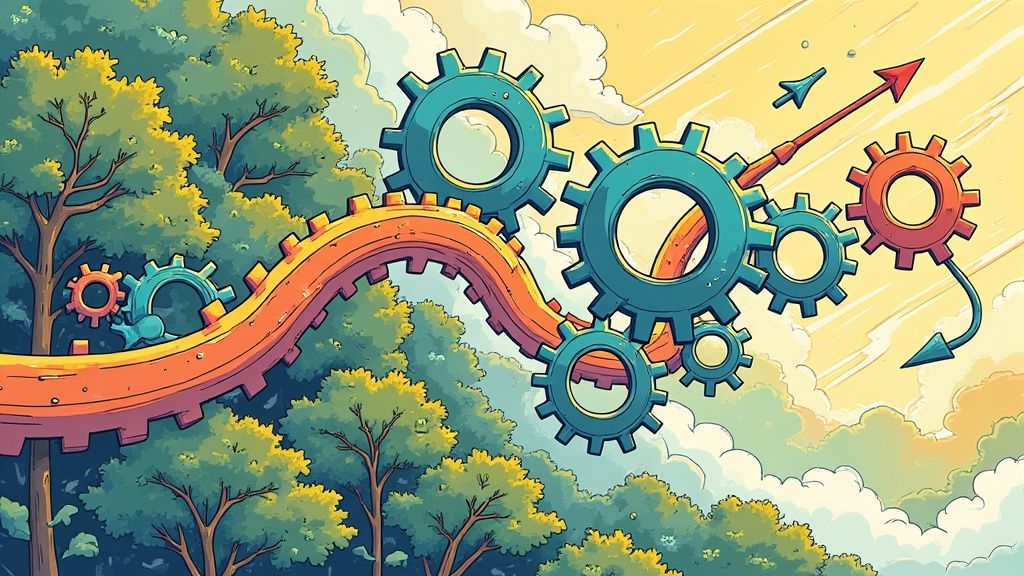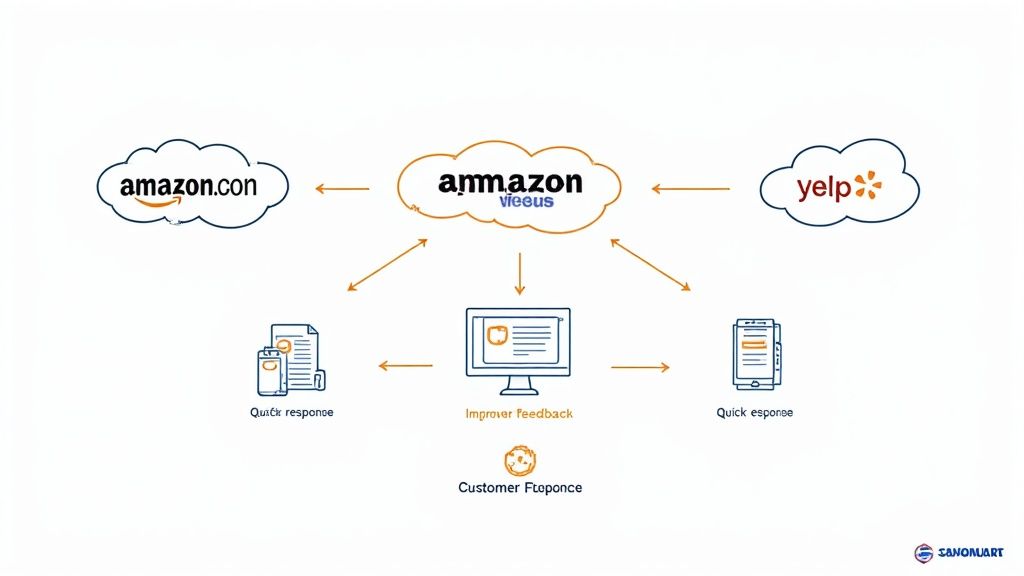8 Feedback Loop Examples Driving Innovation

Understanding Feedback Loops: A Dynamic System
Feedback loops shape how organizations learn, adapt and improve. At their core, feedback loops are cycles where system outputs become inputs, creating an ongoing chain of cause and effect. This basic pattern allows teams and processes to self-correct and evolve based on real results, much like natural systems do. The most effective feedback loops provide clear, timely insights that teams can act on quickly.
Across industries and roles, understanding feedback loops gives you a powerful tool for improvement. Whether you manage customer service quality, develop new products, or run a small business, these cycles help detect what's working and what needs adjustment. The key is creating feedback loops that deliver actionable data you can use to make concrete changes.
This article explores 8 practical examples of feedback loops in action. You'll see how different organizations use them to track performance, spot issues early, and make informed decisions. By the end, you'll be equipped to identify opportunities for feedback loops in your own work and use them to drive better results.
1. Thermostat Temperature Control
The thermostat is one of the clearest examples of a feedback loop in action. Its constant regulation of room temperature offers a perfect introduction for understanding automated control systems. The principles at work are immediately relevant to anyone overseeing customer service quality or workplace conditions.
The system follows a straightforward process. A sensor continuously checks the room temperature and compares it to the temperature you've set. When the temperature strays from your desired setting, the thermostat signals your heating or cooling system to kick in. Once the target temperature is reached, the system shuts off. This creates an ongoing cycle that keeps your space comfortable.
Key Components:
- Temperature sensor: Takes accurate readings of current room temperature
- Set point system: Tracks desired temperature target
- Control mechanism: Turns heating/cooling on or off as needed
- Monitoring system: Keeps constant watch on temperature levels
Benefits:
- Easy to use: Simple interface and operation
- Hands-off operation: Minimal user input needed
- Lower energy bills: Only runs when temperature adjustment is needed
- Temperature stability: Maintains steady comfort levels
Limitations:
- Response lag: Some delay between temperature changes and system reaction
- Temperature swings: Can briefly go above or below target temperature
- Power dependent: Needs constant electricity to function
- Upkeep needs: Regular maintenance required for best performance
Real Applications:
The story of thermostats shows how feedback systems keep getting better. The first mechanical thermostats by Warren Johnson offered basic control. Today's smart thermostats from Nest, Honeywell, and Ecobee use advanced programs to save energy and improve comfort. They learn your schedule, adapt to your preferences, and even check weather forecasts to plan ahead.
Setup Tips:
- Location matters: Keep sensors away from heat sources like sunlight and appliances
- Check accuracy: Regular calibration helps maintain precise readings
- Consider zoning: Multiple thermostats can better control temperature in different areas
Why This Example Works:
The thermostat perfectly demonstrates the core feedback loop elements of monitoring, comparing and adjusting. Its clear connection to everyday comfort and energy use makes it instantly relatable. Understanding how a thermostat works helps build a foundation for grasping more complex feedback systems in other fields.
2. Body Temperature Regulation
The body's temperature control system is a fascinating example of a biological feedback loop that maintains our health. This built-in mechanism keeps our core temperature steady around 98.6°F (37°C) by automatically responding to both internal and external changes. Without this vital system, our bodies couldn't function properly.

The hypothalamus, located in the brain, serves as the control center. Like a smart thermostat, it constantly checks blood temperature and gets updates from sensors throughout the body. When it detects temperature changes, it triggers specific body responses to correct them.
Key Response Mechanisms:
Our bodies use several methods to maintain temperature:
- Sweating: The body releases sweat when overheated. As sweat evaporates, it pulls heat away from the skin
- Shivering: Muscles rapidly contract and relax in cold conditions to generate warmth
- Blood Vessel Changes: Blood vessels near the skin expand to release heat or narrow to keep it in
- Hormone Activity: The body releases hormones that adjust metabolism and heat production
Why It Matters:
This temperature control system played a key role in mammal evolution. By handling temperature regulation automatically, it allowed our ancestors to focus mental energy on other crucial tasks for survival.
Benefits:
- Works without conscious thought
- Has multiple backup mechanisms
- Adjusts to different temperatures
- Runs silently in the background
Limitations:
- Can fail in extreme conditions
- Affected by certain medications
- Less effective with age
Real-Life Examples:
- Heavy sweating during exercise
- Shivering on cold days
- Fever during illness
Business Application:
Consider customer service like body temperature control. Customer satisfaction is your "temperature." When it drops (complaints), activate response systems (support outreach). When it's stable (positive feedback), maintain consistent service. Like the hypothalamus monitors temperature, management should track satisfaction levels. Having multiple support channels helps your system stay responsive to changing customer needs.
3. Customer Feedback Systems
Getting valuable insights from customers is essential for any company's growth. Customer Feedback Systems help businesses understand what customers really think, what needs improvement, and how to provide better products and services. From small businesses to large enterprises, these systems offer critical data that shapes key decisions.

A good feedback system includes several key parts: ways to collect input (like surveys and reviews), tools to analyze patterns, methods to address concerns, and tracking to measure improvements. This helps support teams stay connected to customer needs and allows managers to make targeted updates. For instance, teams can spot common issues with specific features and recommend fixes to product developers.
Key benefits of feedback systems:
- Direct Customer Input: Get unfiltered insights about what customers actually want and need
- Ongoing Improvements: Spot areas to enhance products based on real customer experiences
- Higher Satisfaction: Show customers you listen and care by acting on their feedback
- Better Market Position: Understanding customer needs helps you stay ahead of competitors
Important challenges:
- Takes Resources: Need dedicated time, staff and tools to run an effective system
- Regular Attention Required: Must continuously review and act on feedback data
- Feedback May Not Represent All: Some customer segments may provide more input than others
- Response Time: High feedback volume can slow down individual response times
Real examples in action:
- Amazon Reviews: The company's review system helps shoppers make choices while giving Amazon and sellers key data
- NPS Surveys: Simple surveys measuring if customers would recommend your business
- Social Listening: Tracking social media shows real-time customer opinions
System Growth: Early adopters like Amazon, Yelp, and TripAdvisor showed how feedback drives growth. Online shopping and social media made it easier to gather more customer insights.
Tips for success:
- Use Multiple Channels: Collect feedback in different ways to reach more customers
- Reply Quickly: Show customers their input matters through fast responses
- Watch for Patterns: Note common issues and check if changes are working
- Follow Up: Tell customers how you used their feedback to make improvements
For anyone managing customer experience – from small business owners to support directors – having a strong feedback system is crucial for success. The insights help build better products and happier customers. Want to learn more? Check out our articles on building effective support strategies in our resource library.
4. Audio Feedback Loop
Audio feedback occurs when sound travels from a speaker back into a microphone, creating that distinct howling sound we've all heard. This happens through a continuous loop where the output sound keeps feeding back through the system.
The process has several key parts. The heart of it is the sound amplification cycle – the microphone keeps picking up and boosting the sound over and over. Some frequencies get boosted more than others, leading to that familiar high-pitched whine. As this continues, the system starts to oscillate, causing the trademark howl.
While audio feedback is usually annoying in meetings or presentations, it has found some interesting uses. It helps demonstrate how feedback systems work in a way people can hear and understand. Many famous musicians have turned it into an art form – Jimi Hendrix, The Beatles, and Pete Townshend all used controlled feedback to add raw expression to their music.
This example belongs on our list because it shows both the good and bad sides of feedback loops in a way everyone can relate to. For people managing teams or running businesses, it offers a concrete way to understand how feedback works in other systems, like customer service or product development.
Pros:
- Makes great special effects in music
- Shows how feedback works in a clear way
- Artists use it to create unique sounds
Cons:
- Disrupts most audio systems
- Can harm equipment if too loud
- Makes it hard to hear speech clearly
Examples:
- Hendrix's famous feedback solos
- The squeal from speakers at events
- Guitar amp feedback when close to speakers
Tips for Managing Audio Feedback:
- Position microphones wisely: Keep them away from speakers and point them in different directions
- Use feedback suppressors: These devices help catch and reduce problem frequencies
- Control gain levels: Keep microphone and amp levels in check
- Choose directional microphones: These pick up less unwanted sound from speakers
By getting to know how audio feedback works, you can better control it – either preventing it when unwanted or using it creatively when desired.
5. Performance Review Feedback
Performance reviews are essential tools for evaluating employee performance and providing constructive feedback to improve workplace effectiveness. They create an important feedback loop within organizations that directly impacts individual and team success. Regular evaluation cycles enable consistent monitoring and improvement throughout the year.
Modern performance reviews have moved beyond traditional annual appraisals, which were often seen as bureaucratic exercises with limited value. The focus has shifted to more frequent, two-way feedback discussions that emphasize growth and employee development.
Key elements of effective performance review systems:
- Regular check-ins: Moving from annual to quarterly, monthly or even weekly reviews allows for timely feedback and quick course corrections
- Two-way dialogue: Both managers and employees should provide input on performance, roles and work environment to build open communication
- Clear goals: Using SMART goals (Specific, Measurable, Achievable, Relevant, Time-bound) aligned with business objectives provides clear direction
- Growth planning: Reviews should focus on future development opportunities, not just past performance
Benefits:
- Career development: Provides clear pathways for professional growth
- Role clarity: Ensures shared understanding of responsibilities
- Performance gains: Offers specific feedback for improvement
- Progress tracking: Creates documentation to support career advancement
Challenges:
- Potential bias: Reviews can be subjective without proper guidelines
- Resource intensive: Requires significant time from managers and staff
- Employee anxiety: Reviews may create stress if not handled well
- Manager training: Leaders need skills to deliver effective feedback
Common review approaches:
- Annual evaluations: Traditional yearly reviews, now often supplemented with more frequent feedback
- 360-degree feedback: Input from peers, direct reports and managers provides fuller perspective
- Ongoing feedback: Using tools to enable regular feedback and recognition
Best practices for reviews:
- Give specific examples: Use concrete situations rather than generalizations
- Focus on actions: Discuss behaviors and impact, not personality
- Balance feedback: Include both strengths and areas for growth
- Set clear goals: Work together to define measurable objectives
Success Story: After implementing regular feedback check-ins, a software company saw 20% faster project delivery times and higher engagement scores. The new system enabled quick adjustments and fostered more open communication between teams.
Well-designed performance review processes create powerful feedback loops that drive continuous improvement, support employee development, and help organizations succeed. The key is making reviews frequent, specific and focused on growth.
6. Population Dynamics
Population dynamics showcases nature's most elegant feedback loops in action. These systems control population sizes through the interplay of predator-prey relationships, available resources, and environmental conditions. Rather than requiring external controls, these natural mechanisms maintain healthy ecosystem balance through continuous feedback and adjustment.

Key Elements of Population Dynamics:
- Species Interactions: Multiple species connect through complex food webs and relationships
- Resource Limits: Food, water, and shelter availability directly affect population changes
- Environmental Factors: Weather patterns, natural events, and diseases impact populations
- Natural Balance: Predator-prey cycles create an ongoing balance, preventing any single species from growing unchecked
Benefits of Natural Population Control:
- Self-Adjusting: The system naturally corrects imbalances without outside intervention
- Ecosystem Health: Prevents single-species dominance and maintains diversity
- Species Diversity: Supports many different species, making ecosystems more stable
- Evolution: Drives natural selection and adaptation over time
Limitations and Challenges:
- Human Impact: Activities like habitat loss and hunting can break these natural cycles
- Climate Effects: Environmental shifts can disrupt established population patterns
- Population Swings: Some species experience dramatic ups and downs in numbers
Real Examples in Nature:
- Yellowstone Wolves: When wolves returned to Yellowstone, they reduced elk numbers, which allowed vegetation to recover and even changed river patterns
- Rabbit and Fox Cycles: Classic example showing how predator numbers rise and fall in response to prey availability
- Ocean Food Chains: Plankton populations support fish numbers, creating natural checks and balances
Why This Matters:
Population dynamics offers clear lessons about how feedback systems work in nature. These patterns show how different parts of a system affect each other and maintain balance over time. While different from business feedback loops, these natural examples help explain how interconnected factors influence outcomes in any complex system.
These insights can guide better decision-making in other fields. For instance, customer feedback shapes product improvements much like predator pressure drives prey adaptation. Understanding these natural patterns helps leaders make choices that consider long-term effects and connections between different parts of their systems.
7. Market Price Mechanism
The market price mechanism is the basic process where prices of goods and services change based on supply and demand. This system helps distribute resources efficiently in free markets and impacts how businesses set prices and manage resources.
Think of it like a constant back-and-forth between buyers and sellers. When people want more of something that's in limited supply, prices go up. Higher prices encourage producers to make more while discouraging some buyers, eventually balancing things out. When there's too much supply, prices drop until more people buy and less gets produced.
Key Elements:
- Price signals: Prices show if something is scarce or plentiful
- Supply-demand balance: The ongoing relationship between what's available and what people want
- Market clearing: The process of finding the right price where supply matches demand
- Continuous adjustment: Prices keep changing as market conditions shift
Real Examples:
- Stock market: Share prices change constantly based on company news and market sentiment. Good earnings reports can quickly drive up a stock's price.
- Commodities: Products like oil, gold and grain respond strongly to global supply and demand. A bad harvest season often leads to higher grain prices.
- Housing: When many people want to buy homes but few are for sale, prices rise. During downturns, too many homes for sale pushes prices lower.
History:
Adam Smith first described market forces in "The Wealth of Nations" (1776) with his concept of the "invisible hand." Later economists like Friedrich Hayek and Milton Friedman built on these ideas about free markets and price signals. Their work helped establish the market price mechanism as a fundamental economic principle.
Tips for Business Success:
- Watch market trends: Stay informed about supply and demand shifts that affect your pricing
- Study competitor prices: Know how others price similar products
- Keep prices flexible: Adjust based on changing conditions
- Know your customers: Understand how price changes impact buyer behavior
Benefits:
- Self-correcting: Works without central control
- Good resource allocation: Directs resources to where they're most needed
- Fast adaptation: Quickly responds to changes
- Decentralized: No need for complex oversight
Drawbacks:
- Can be gamed: Big players may manipulate prices
- Creates gaps: Can lead to uneven wealth distribution
- Market failures: Problems like monopolies can disrupt normal function
- Speculation: Price bubbles can form and burst
The market price mechanism is vital to understanding how modern economies work. When businesses grasp how supply and demand affect prices, they can make smarter decisions about pricing, production and strategy. This natural balancing system remains one of the most important feedback loops in business and economics.
8. Social Media Engagement
Social media platforms use feedback loops between user actions and content visibility to shape what people see online. This interplay between how users interact with content and how algorithms adjust to those behaviors drives today's social media experience. Understanding these dynamics is key for anyone managing customer support, online communities, or business social media.
Core Engagement Mechanics:
When users like, share, comment on, save, or spend time viewing content, platforms track these signals to learn preferences and predict what will resonate. Content that gets more engagement appears to wider audiences. This creates viral effects where popular posts spread rapidly across networks. The ongoing cycle helps platforms refine content delivery based on what people actually find valuable.
Notable Platform Examples:
-
Facebook News Feed: The original personalized feed that shows content based on friends' interactions. Posts with high engagement from your network appear more prominently. The system now considers content type and your engagement history.
-
Twitter Trends: Shows how topics gain momentum in real-time. As more people tweet about something, it rises in visibility, leading even more users to join the conversation.
-
TikTok For You Page: Analyzes detailed signals like watch time, replays, and subtle viewing patterns. This creates highly personalized feeds that keep users watching longer.
Growth and Development:
As social platforms gained millions of users, they needed smart ways to filter massive amounts of content. Basic chronological feeds evolved into personalized experiences powered by engagement data.
Tips for Success:
- Track Key Metrics: Monitor likes, shares, comments and use platform analytics to understand your audience
- Try Different Content: Test videos, images, text posts to see what works best
- Build Community: Respond to comments, join discussions, create conversations
- Post Strategically: Share content when your audience is most active
Benefits:
- Quick Distribution: Popular content spreads organically
- Personalization: Content matches user interests
- Community Growth: People connect over shared topics
- Content Insights: Data shows what resonates
Challenges:
- Echo Chambers: People see mainly content that confirms existing views
- Low Quality Content: Attention-grabbing posts get more engagement
- Data Collection: User tracking raises privacy questions
- Overuse Risk: Engagement mechanics can be habit-forming
Social media engagement systems are central to how people interact online today. Understanding these dynamics helps businesses connect with customers and build active communities. The key is using engagement data thoughtfully while avoiding common pitfalls. With the right approach, organizations can develop meaningful social media presences that provide real value.
8 Feedback Loop Examples Comparison
| Concept | 🔄 Implementation Complexity | ⚡ Resource Requirements | 📊 Expected Outcomes | ⭐ Ideal Use Cases | 💡 Key Advantages |
|---|---|---|---|---|---|
| Thermostat Temperature Control | Moderate: sensor-driven automation | Low power consumption; modest hardware demands | Stable room temperature maintenance | Indoor climate control in homes/offices | Energy efficient; precise control |
| Body Temperature Regulation | Complex: multi-hormone and autonomous responses | None externally; relies on natural biological processes | Consistent homeostasis through varied responses | Biological systems; medical and health contexts | Highly adaptive with multiple backup mechanisms |
| Customer Feedback Systems | Moderate: integrated digital tools and processes | High: requires data analytics, software, and continuous monitoring | Continuous improvement of products and services | Businesses seeking direct customer insights | Direct insights; competitive advantage |
| Audio Feedback Loop | Low: straightforward acoustic re-amplification | Low, though uncontrolled feedback can risk equipment integrity | Amplified sound effects; potential disruptive outcomes | Creative audio demonstrations and live performances | Demonstrates feedback principles; artistic utilization |
| Performance Review Feedback | Moderate: structured evaluation cycles and dialogue | Medium: involves human resources and documentation efforts | Enhanced employee performance and goal alignment | Organizational HR and professional growth strategies | Promotes growth through clear, structured feedback |
| Population Dynamics | High: complex ecological interactions and variables | Low: natural process, yet sensitive to external environmental changes | Ecosystem balance and population regulation | Ecological research and environmental management | Self-regulating; promotes biodiversity |
| Market Price Mechanism | Moderate: dynamic adjustments via market forces | Low: decentralized process leveraging supply & demand dynamics | Efficient resource allocation via responsive pricing | Economic modeling and resource allocation analysis | Decentralized efficiency; rapid response to market shifts |
| Social Media Engagement | Moderate: algorithm-driven content feedback loops | High: intensive computational resources and real-time data handling | Optimized content distribution with viral reach | Digital marketing and community engagement strategies | Rapid engagement insights; adaptive content optimization |
The Power of Feedback: Continuous Adaptation and Improvement
Feedback is essential for growth and progress across all systems – from nature to business. When a thermostat adjusts temperature, your body maintains homeostasis, or a company acts on customer input, these feedback mechanisms enable constant fine-tuning. Looking at examples like performance reviews, market dynamics, and social interactions shows just how broad the impact of feedback can be. Understanding these patterns helps us use them effectively.
Getting the most out of feedback requires commitment to gathering input, analyzing results, and making changes. This means creating strong feedback channels, developing smart ways to evaluate the data, and building a culture that welcomes both praise and constructive criticism. The key is treating it as an ongoing cycle – constantly checking how well changes work and adjusting based on new information.
As technology advances, we're seeing new tools emerge for collecting and processing feedback. Real-time feedback systems, data analytics, and AI tools for analyzing sentiment are making it easier than ever to understand and act on input quickly.
Key Points:
- Feedback drives adaptation and steady improvement
- Active listening and analysis are essential for using feedback well
- Learning and adjusting need to be continuous
- Technology is making feedback processes more effective
Ready to improve your customer support with real-time feedback? SupportMan connects Intercom ratings directly to Slack, helping teams respond instantly to customer input and keep getting better. Skip the dashboard digging and focus on feedback that matters. Try SupportMan free – no credit card needed! Get started with Supportman
What to do next
Whenever you're ready, here's three ways we can help you scale your support org:
- Claim your free Support Manager Handbook. It's a free 30+ page guide filled with strategies, tactics, and best practices for scaling your support org. Download it here.
- Subscribe to our Support Ops newsletter to get the latest updates here.
- Set up Internal Documentation with Tettra to start automatically answering the questions you get in Slack. Here's how.

